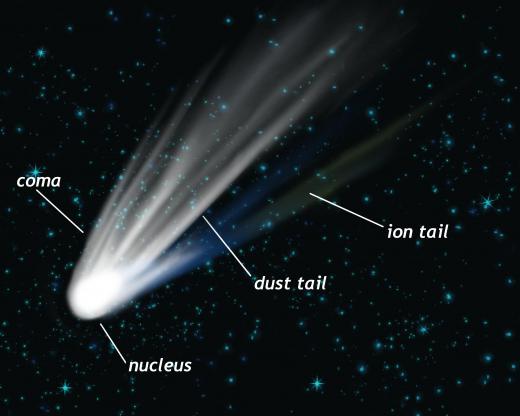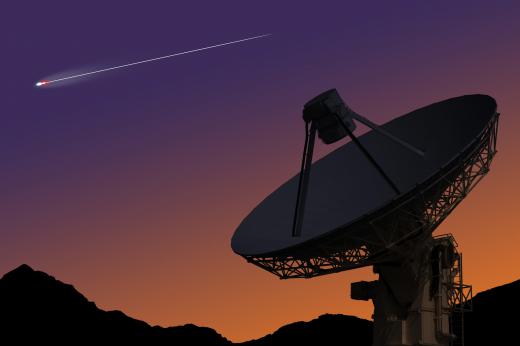What is the Difference Between a Comet and a Meteor?
 Michael Pollick
Michael Pollick
There are quite a few objects in the universe capable of causing a really, really bad day on planet Earth, including a wayward comet or large asteroid. Most meteors, however, are not very high on an astronomer's scale of scary extraterrestrial events. There are a number of differences between a comet and a meteor, from their general composition to the roles they play in the universe.
A comet is a celestial object believed to be composed primarily of space dust and frozen gases. Experts think they are born somewhere in the outer parts of the universe and are not related to the formation of our solar system at all. A comet follows an orbit that may bring it close to a star, such as the Sun, and as it approaches the star, a portion of its ice core may melt and release a trail of dust-sized particles. This cycle can continue for millions of years.

A meteor, on the other hand, is a bit of rock or other debris, and it does not follow an orbit around the Sun. It even has a different name while it remains floating in outer space — it's called a meteoroid. It's only known as a meteor when it enters the Earth's atmosphere.
When the Earth passes through a comet's trail or debris field, individual meteoroids hit or skip across the first layers of the atmosphere. Observers on Earth may be fortunate enough to see the last few seconds of the existence of this debris as it streaks across the sky and burns up. Unlike a comet, a meteor will not return a number of years later.

A comet rarely passes within a few million miles of the Earth, while a meteor, by its very definition, must strike the first layers of the Earth's atmosphere. The arrival of a comet can be predicted with some degree of accuracy, and it can rarely be seen with the naked eye. Meteors can enter the Earth's atmosphere at any time of the day or night and during a shower, it is not unusual to see dozens or even hundreds of them within a few hours.

Scientists give comets official names for identification, such as Swift-Tuttle, Hale-Bopp or Halley's Comet. A few large asteroids may receive identifying names as well, but meteors do not. Virtually all of these objects cease to exist once they've entered the Earth's atmosphere, although a rare few make it to the ground. Once it has made contact with the Earth's surface, it becomes known as a meteorite. While a comet may be composed of space dust, organic materials, and ice, most meteors contain elemental metals, such as iron, along with inorganic minerals, such as quartz.
AS FEATURED ON:
AS FEATURED ON:














Discussion Comments
The Orionids are also annual meteor showers, as are the Geminids, the Lyrids, the Quadrantids, the Perseids and the Capricornids.
@ Aplenty-The reason that meteor showers are best during predawn hours is because you are looking at the side of the earth that is rotating towards the sun. The sunrise horizon is the first part of the earth to pick up meteroids flying through space so the rate of meteors per hour is the highest near sunrise.
I also wanted to point out the fact that the Perseids Meteor Shower is an annual event. The shower is the result of a particle cloud created by the tail of the Swift-Tuttle Comet. The earth passes through the cloud creating the Perseids Meteor Shower.
I can't remember my last comet sighting, but I was able to watch the Perseid Meteor Shower from the desert. This year’s Perseid Meteor Shower was one of the best showers I have seen. I saw a few meteors that were long and bright.
The night was clear and the moon was only a sliver. The moon also set early, making the shower a great light show. I saw the best meteors at about four in the morning. I wonder why that is.
I vaguely remember the last time Halley's Comet was visible. I do not actually remember seeing the comet (I was just entering elementary school), but I remember all the hype surrounding the comets pass near earth.
Halley's Comet only shows up every 76 years or so, and is the only short-cycle comet that is visible to the naked eye. The next time Halley's Comet returns will be somewhere around 2061. Maybe I will be one of the lucky people who get to see Halley's Comet twice in a lifetime.
And what of the Stardust results that appear to contradict the standard model's claim that comets are large balls of sublimating ice formed at the cold outer reaches of the "Oort Cloud?" IE, materials collected in the Stardust mission turned out to be crystals and other materials that can only be created under stressful, high-pressure, extremely hot conditions? Does this not falsify the standard model's claim? Likewise, what about "centaurs" or planetoids between the orbit of Jupiter and Neptune which appear to display both properties of asteroid AND comets. IE, they're large hunks of space rock, but still display comet-like attributes. And what of the recent proclamation of the first short-periodic comet with a period of appx 4 years that happens to look a lot like an asteroid, but flares up at its closest approach to the sun?
Isn't the main difference between a comet and an asteroid its orbit (eccentric vs stable/circular) and its charge relative to the surrounding plasma and the sun's radial electric field (including the heliospheric current sheet)? IE, as an object that spends a good portion of its time in the outer system falls through the sun's radial electric field and plasmasphere, it becomes increasingly out of balance with the local plasma. Thusly, it exits dark current mode and enters glow mode and we begin to see the "visible" coma (which displays electrical characteristics such as emitting copious x-rays, remaining filamentary and not significantly mixing with the solar wind over vast distances within the solar system, rather than dissipating like a neutral gas cloud in a vacuum).
Post your comments